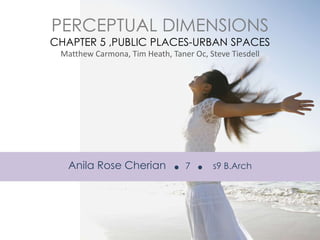
chapter 5, public places urban spaces- Perceptual dimensions
- 1. PERCEPTUAL DIMENSIONS CHAPTER 5 ,PUBLIC PLACES-URBAN SPACES Matthew Carmona, Tim Heath, Taner Oc, Steve Tiesdell Anila Rose Cherian . . 7 s9 B.Arch
- 2. Environmental perception We affect the environment and are affected by it. For this interaction to happen we must „perceive‟ i.e. be stimulated by sight, sound, smell or touch. It involves gathering, organizing and making sense of the environment. Sensation and perception Vision Hearing Smell Touch These sensory stimuli are perceived and apprecitiated as an interconnected whole. It provides a cumulative effect. Dimensions of perception Cognition: thinking about, organizing, making sense of the environment Affective : our feelings, which influence perception of environment and perception that influences feelings Interpretative : meaning / association derived from environment. We rely on memory for points of comparison with newly experienced stimuli Evaluative : incorporates values and preferences and the determination of „good or „bad‟
- 4. Perception is not only biological, but a social and cultural learnt process as well. It depends of factors like gender, age, ethnicity, lifestyle, length of residence in an area, and on physical, social and cultural environment in which a person lives and was raised. Workable environmental images requires three attributes: Identity. Structure. Meaning Kevin Lynch‟s image of the city is based on the concept of mental mapping; Imageability Lynch separated meaning from form and explored imageability in terms of physical qualities relating to identity and structure. He derived 5 key physical elements through mental mapping / cognitive exercises in observers. Paths Edges Districts Nodes Landmarks
- 6. BEYOND THE IMAGE OF A CITY Areas of criticism in Lynch‟s findings and methods. Observer variation Legibility and imageability Meaning and symbolism Conclusion drawn was that social and emotional meanings attached to, or evoked by the elements of the urban environment were at least as important than the structural and physical aspects of peoples imagery. ENVIRONMENTAL MEANING AND SYMBOLISM Sign – signification, signifier, signified Iconic signs – direct similarity with object Indexical signs – material relationship with object Symbolic signs – arbitrary relationship with object Semiotics involves the layering of meanings First order sign / primary function – denotation Second order sign / secondary function – connotation Buildings in an environment are a symbol in itself. Modernists sought to escape from symbolizing buildings. They designed to express internal functions. Post modern style arose to have multiple meanings.
- 7. THE CONSTRUCTION OF PLACE „Sense of place‟- can be understood in terms of „genius loci‟ , Latin concept that people experience something beyond the physical or sensory properties of places and can feel an attachment to a spirit of a place.(Jackson, 1994 p.157) Eg.Paris, Disney Land, Las Vegas, New York Phenomenology: while meanings are rooted in their physical settings and activities, they are not a property of them, but of human interactions and experiences. Thus what „the environment‟ represents is a function of our own subjective construction of it. „place‟ – „belonging‟ Territoriality and personalization „inside‟-‟outside‟ of a „place‟ Individual identity is associated with personalization and putting a distinctive stamp on ones environment. It is a „unique address‟ Place = space in image of man Occasion = time in image of man Successful places have animation and vitality. They offer what people want in an attractive and safe environment. Key attributes : comfort and image, access and linkage, uses and activity, and sociability (Project for Public Space (1999))
- 8. Placelessness “There is no there, there” ,Gertrude Stein Negative concept-tends to signify absence or loss of meaning Casual eradication of distinctive places and making of standardized landscapes. Factors contributing to placelessness Globalization : world is interconnected , central decision making, two scenarios - convergence where sameness emerges and divergence where disparate elements maintain cultural and spatial distinctiveness Mass culture : homogenisation, destroying local cultures Loss of (attachment) to territory : no care for environment when there is no sense of belonging. „Existential outsideness‟ ‘Invented’ places Manufacturing of differences- invention or reinvention of places. Places „imagineered‟ to create uniqueness to attract attention and visitors and in turn make money. Invented places are the fiction of architects, authors, artists, designers, imagineers eg. Disney Land, shopping malls This concept raises issues like Superficiality, other-directedness, lacking authenticity
- 9. Superficiality : depthlessness, undermining the real/unique identity of a place. Architectural „fetishism‟ Other-directedness – created from without rather than within : outside inventions, rather than autonomous expressions of local culture,meanings and associations. „Economic space‟ invades „lived space‟. Lacking authenticity : critics regard explicit copies/ references from past in urban context as „false‟ and „lacking authenticity‟ Public cannot distinguish what is real and what is not (Huxtable, The unreal America) Criticism of invented places provokes the question: why shouldn’t urban design produce places that people like and enjoy? Although urban design as a process invents or reinvents places with authenticity or lack of it, it is the people who make places and give them meaning It is the peoples perceptions that are important.
- 10. THANK YOU
